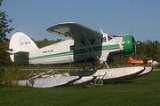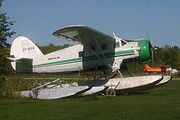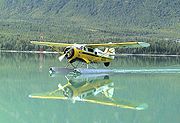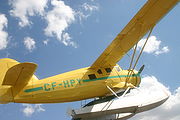
Noorduyn Norseman
Encyclopedia
The Noorduyn Norseman is a Canadian
single-engine bush plane
designed to operate from unimproved surfaces. Norseman aircraft are known to have been registered and/or operated in 68 countries throughout the world and also have been based and flown in the Arctic and Antarctic regions.
, the Noorduyn Norseman was produced from 1935 to 1959, originally by Noorduyn Aircraft Ltd.
and later by the Canada Car and Foundry company.
With the experience of working on many ground-breaking designs at Fokker
, Bellanca and Pitcairn-Cierva, Noorduyn decided to create his own design in 1934, the Noorduyn Norseman. Along with his colleague, Walter Clayton, Noorduyn created his original company, Noorduyn Aircraft Limited in early 1933 at Montreal
while a successor company bearing the name, Noorduyn Aviation, was established in 1935.
 Noorduyn's vision of a bush plane revolved around a few basic criteria: it should be an aircraft with which a Canadian operator utilizing existing talents, equipment and facilities could make money, it should be a high-wing monoplane to facilitate loading and unloading of passengers and cargo at seaplane docks and airports and, finally, it should be an all-around superior aircraft to those in use in Canada. From the outset, Noorduyn designed the transport to have interchangeable wheel, ski or twin-float landing gear. Unlike most aircraft designs, the Norseman was first fitted with floats, then skis and, finally, fixed landing gear.
Noorduyn's vision of a bush plane revolved around a few basic criteria: it should be an aircraft with which a Canadian operator utilizing existing talents, equipment and facilities could make money, it should be a high-wing monoplane to facilitate loading and unloading of passengers and cargo at seaplane docks and airports and, finally, it should be an all-around superior aircraft to those in use in Canada. From the outset, Noorduyn designed the transport to have interchangeable wheel, ski or twin-float landing gear. Unlike most aircraft designs, the Norseman was first fitted with floats, then skis and, finally, fixed landing gear.
The final design layout looked much like Noorduyn's earlier Fokker designs, it was a high-wing braced monoplane with an all-welded steel tubing fuselage structure and wood stringers applied to it for the attachment of a fabric skin. The Norseman's wing had an all wood construction and was fabric covered, except for the flaps and ailerons, which were made of welded steel tubing. It had a divided type landing gear fitted to fuselage stubs, the legs were secured with two bolts each to allow the alternate arrangement of floats or skis. The tail wheel strut could be fitted with a wheel or tail skid.
 The first Norseman, powered by a Wright R-975-E3 Whirlwind, was flight tested on floats on November 14, 1935 and was sold and delivered to Dominion Skyways Ltd. on January 18, 1936, registered as "CF-AYO" and named “Arcturus." In summer 1941, Warner Brothers leased CF-AYO for the filming of "Captains of the Clouds
The first Norseman, powered by a Wright R-975-E3 Whirlwind, was flight tested on floats on November 14, 1935 and was sold and delivered to Dominion Skyways Ltd. on January 18, 1936, registered as "CF-AYO" and named “Arcturus." In summer 1941, Warner Brothers leased CF-AYO for the filming of "Captains of the Clouds
" starring James Cagney
. Principal aerial photography took place near North Bay, Ontario
with CF-AYO carrying temporary registration "CF-HGO." CF-AYO was lost in a crash in Algonquin Park in 1952. Its wreckage currently is on display at the Canadian Bushplane Heritage Centre
.
Almost immediately, the Norseman proved itself to be a rugged, reliable workhorse with steady sales. The first aircraft, CF-AYO, was designated the Norseman Mk I. The next aircraft, "CF-BAU," having some minor changes required after the certification tests, and a new Pratt & Whitney R-1340
Wasp SC-1 engine up-rated from 420 to 450 hp, was designated Norseman Mk II while the next three aircraft were Norseman Mk IIIs: "CF-AZA" going to MacKenzie Air Service, Edmonton, Alberta, "CF-AZE" to Prospector Airways, Clarkson, Ontario and "CF-AZS" to Starrat Airways, Hudson, Ontario. "CF-BAU" would be modified on June 26, 1937 to became the prototype Norseman Mk IV, powered by a Pratt & Whitney Wasp S3H-1. The Mk IV become the "definitive" model but the production run might have ended at a few hundred examples if not for the advent of the Second World War
.
 Until 1940, the Noorduyn company had sold only 17 aircraft in total, primarily to commercial operators in Canada's north and to the Royal Canadian Mounted Police
Until 1940, the Noorduyn company had sold only 17 aircraft in total, primarily to commercial operators in Canada's north and to the Royal Canadian Mounted Police
. With the outbreak of war in Europe, demand for a utility transport led to major military orders. The Royal Canadian Air Force
and the United States Army Air Forces
became the two largest operators; the RCAF ordered 38 Norseman Mk IVWs for radio and navigational training for the Commonwealth Air Training Plan.
USAAF Colonel Bernt Balchen
had been involved in establishing a staging route across Greenland to facilitate the ferrying of aircraft from North America to Europe. He required a bush plane rugged enough to survive in the harsh conditions of the Arctic. After evaluating six Norsemans diverted from a previous RCAF order, late in 1941, he recommended the purchase of the Norseman Mk IV specially modified to USAAF requirements as the YC-64A. After the US entry into the Second World War, the USAAF placed the first of several orders for a production version C-64A Norseman. The principal differences involved fitting two fuselage belly tanks bringing the standard fuel capacity to 201 Imp. gal (914 l); an additional cabin fuel tank of 32 Imp. gal (145 l) could also be installed. These changes resulted in an increase of 950 lb (431 kg) in the loaded weight of the standard Mk IV. Deliveries began in mid-1942, with the American military eventually placing orders for 749 Norseman Mk IVs as the C-64A (later UC-64A).
Throughout the Second World War, the USAAF Norseman aircraft were used in North America (primarily Alaska) as well as other in theaters of war, including Europe. Three UC-64As were used by the US Navy under the designation JA-1. Six C-64B floatplanes were used by the US Army Corps of Engineers, as well as by other Allied air forces, who placed orders for 43 Norseman Mk IVs. The RCAF ordered an additional 34 aircraft as Norseman Mk VI. Noorduyn was the sole manufacturer, but when the USAAF considered ordering a larger number of C-64As, license production of 600 by Aeronca Aircraft
Corp. (Middletown, Ohio) was contemplated before the contract was cancelled in 1943.
It was a Norseman in which Glenn Miller
was flying as a passenger when he disappeared over the English Channel
on December 15, 1944.
 In postwar production, the Canada Car and Foundry in Fort William, Ontario
In postwar production, the Canada Car and Foundry in Fort William, Ontario
acquired rights to the Norseman design, producing a version known as the Norseman Mk V, a civilian version of the wartime Mk IV. In order to exploit the market further, the "Can Car" factory designed and built the Norseman Mk VII. This version had a bigger engine, a new all-metal wing and greater cargo capacity but was fated never to go into production. With large Korean War commitments at that time, the company put it into temporary storage where it was destroyed in a hangar fire in September 1951.
In 1953, Noorduyn headed a group of investors who bought back the jigs and equipment from Canada Car and Foundry and started a new company called Noorduyn Norseman Aircraft Ltd. Bob Noorduyn became ill and died at his home in South Burlington, Vermont on 22 February 1959 but the company he had created, provided support for operating Norseman aircraft and even built three new Mk Vs before selling its assets in 1982 to Norco Associates. Norco provided support services only, as the manufacture of a new Norseman aircraft, being labor intensive, was very expensive.
The last Noorduyn Norseman to be built was sold and delivered to a commercial customer on January 19, 1959. A total of 903 Norseman aircraft (Mk I - Mk V) were produced and delivered to various commercial and military customers. There are currently 30 Norseman aircraft on the active Canadian aircraft registry. The number in use worldwide is not known.
In recognition of the Norseman's role in serving the remote villages of northern Canada, the town of Red Lake, Ontario
, a jumping-off point for remote communities in Northwestern Ontario
, promotes itself as The Norseman Capital of the World. Each summer in July, the "Norseman Floatplane Festival" brings Norseman aircraft to Red Lake as the centrepiece of a community based weekend festival ranging from stage entertainment, children's games and rides, contests, cultural and historical displays and street vendors with craft and specialty booths.
The Canadian Second World War "ace-of-aces" George Beurling died in a Norseman while landing at Urbe Airport in Rome, Italy, in 1948.
Norseman aircraft have appeared in the films Grey Owl
(1999) and The Snow Walker
(2003).
Canada
Canada is a North American country consisting of ten provinces and three territories. Located in the northern part of the continent, it extends from the Atlantic Ocean in the east to the Pacific Ocean in the west, and northward into the Arctic Ocean...
single-engine bush plane
Bush plane
A bush airplane is a general aviation aircraft serving remote, undeveloped areas of a country, usually the African bush, Alaskan and Canadian tundra or the Australian Outback...
designed to operate from unimproved surfaces. Norseman aircraft are known to have been registered and/or operated in 68 countries throughout the world and also have been based and flown in the Arctic and Antarctic regions.
Design and development
Designed by Robert B.C. NoorduynRobert B.C. Noorduyn
Robert B.C. Noorduyn was an aircraft designer and manufacturer.-Early life:...
, the Noorduyn Norseman was produced from 1935 to 1959, originally by Noorduyn Aircraft Ltd.
Noorduyn
The Noorduyn Aircraft Ltd., founded by Robert B. C. Noorduyn, was established in Canada in early 1934 by taking over the Curtiss-Reid factory outside of Montreal, Quebec. Work soon started on the Noorduyn Norseman I...
and later by the Canada Car and Foundry company.
With the experience of working on many ground-breaking designs at Fokker
Fokker
Fokker was a Dutch aircraft manufacturer named after its founder, Anthony Fokker. The company operated under several different names, starting out in 1912 in Schwerin, Germany, moving to the Netherlands in 1919....
, Bellanca and Pitcairn-Cierva, Noorduyn decided to create his own design in 1934, the Noorduyn Norseman. Along with his colleague, Walter Clayton, Noorduyn created his original company, Noorduyn Aircraft Limited in early 1933 at Montreal
Montreal
Montreal is a city in Canada. It is the largest city in the province of Quebec, the second-largest city in Canada and the seventh largest in North America...
while a successor company bearing the name, Noorduyn Aviation, was established in 1935.

The final design layout looked much like Noorduyn's earlier Fokker designs, it was a high-wing braced monoplane with an all-welded steel tubing fuselage structure and wood stringers applied to it for the attachment of a fabric skin. The Norseman's wing had an all wood construction and was fabric covered, except for the flaps and ailerons, which were made of welded steel tubing. It had a divided type landing gear fitted to fuselage stubs, the legs were secured with two bolts each to allow the alternate arrangement of floats or skis. The tail wheel strut could be fitted with a wheel or tail skid.
Operational history

Captains of the Clouds
Captains of the Clouds is a 1942 Warner Bros. war film in Technicolor, directed by Michael Curtiz and starring James Cagney. It was produced by William Cagney , with Hal B. Wallis as executive producer. The screenplay was written by Arthur T. Horman, Richard Macaulay and Norman Reilly Raine,...
" starring James Cagney
James Cagney
James Francis Cagney, Jr. was an American actor, first on stage, then in film, where he had his greatest impact. Although he won acclaim and major awards for a wide variety of performances, he is best remembered for playing "tough guys." In 1999, the American Film Institute ranked him eighth...
. Principal aerial photography took place near North Bay, Ontario
North Bay, Ontario
North Bay is a city in Northeastern Ontario, Canada. It is the seat of Nipissing District, and takes its name from its position on the shore of Lake Nipissing.-History:...
with CF-AYO carrying temporary registration "CF-HGO." CF-AYO was lost in a crash in Algonquin Park in 1952. Its wreckage currently is on display at the Canadian Bushplane Heritage Centre
Canadian Bushplane Heritage Centre
Canadian Bushplane Heritage Centre , located on the north bank of the St. Marys River in Sault Ste. Marie, Ontario, Canada, is dedicated to preserving the history of bush flying and forest protection in Canada...
.
Almost immediately, the Norseman proved itself to be a rugged, reliable workhorse with steady sales. The first aircraft, CF-AYO, was designated the Norseman Mk I. The next aircraft, "CF-BAU," having some minor changes required after the certification tests, and a new Pratt & Whitney R-1340
Pratt & Whitney R-1340
|-See also:* Pratt & Whitney Wasp series* Pratt & Whitney R-985 Wasp Junior* Pratt & Whitney R-1535 Twin Wasp Junior* Pratt & Whitney R-1830 Twin Wasp-Bibliography:...
Wasp SC-1 engine up-rated from 420 to 450 hp, was designated Norseman Mk II while the next three aircraft were Norseman Mk IIIs: "CF-AZA" going to MacKenzie Air Service, Edmonton, Alberta, "CF-AZE" to Prospector Airways, Clarkson, Ontario and "CF-AZS" to Starrat Airways, Hudson, Ontario. "CF-BAU" would be modified on June 26, 1937 to became the prototype Norseman Mk IV, powered by a Pratt & Whitney Wasp S3H-1. The Mk IV become the "definitive" model but the production run might have ended at a few hundred examples if not for the advent of the Second World War
World War II
World War II, or the Second World War , was a global conflict lasting from 1939 to 1945, involving most of the world's nations—including all of the great powers—eventually forming two opposing military alliances: the Allies and the Axis...
.
Second World War

Royal Canadian Mounted Police
The Royal Canadian Mounted Police , literally ‘Royal Gendarmerie of Canada’; colloquially known as The Mounties, and internally as ‘The Force’) is the national police force of Canada, and one of the most recognized of its kind in the world. It is unique in the world as a national, federal,...
. With the outbreak of war in Europe, demand for a utility transport led to major military orders. The Royal Canadian Air Force
Royal Canadian Air Force
The history of the Royal Canadian Air Force begins in 1920, when the air force was created as the Canadian Air Force . In 1924 the CAF was renamed the Royal Canadian Air Force and granted royal sanction by King George V. The RCAF existed as an independent service until 1968...
and the United States Army Air Forces
United States Army Air Forces
The United States Army Air Forces was the military aviation arm of the United States of America during and immediately after World War II, and the direct predecessor of the United States Air Force....
became the two largest operators; the RCAF ordered 38 Norseman Mk IVWs for radio and navigational training for the Commonwealth Air Training Plan.
USAAF Colonel Bernt Balchen
Bernt Balchen
Bernt Balchen, , a winner of the Distinguished Flying Cross was a Norwegian native, and later U.S. citizen, known as a pioneer polar aviator, navigator, aircraft mechanical engineer and military leader. His service in the U.S...
had been involved in establishing a staging route across Greenland to facilitate the ferrying of aircraft from North America to Europe. He required a bush plane rugged enough to survive in the harsh conditions of the Arctic. After evaluating six Norsemans diverted from a previous RCAF order, late in 1941, he recommended the purchase of the Norseman Mk IV specially modified to USAAF requirements as the YC-64A. After the US entry into the Second World War, the USAAF placed the first of several orders for a production version C-64A Norseman. The principal differences involved fitting two fuselage belly tanks bringing the standard fuel capacity to 201 Imp. gal (914 l); an additional cabin fuel tank of 32 Imp. gal (145 l) could also be installed. These changes resulted in an increase of 950 lb (431 kg) in the loaded weight of the standard Mk IV. Deliveries began in mid-1942, with the American military eventually placing orders for 749 Norseman Mk IVs as the C-64A (later UC-64A).
Throughout the Second World War, the USAAF Norseman aircraft were used in North America (primarily Alaska) as well as other in theaters of war, including Europe. Three UC-64As were used by the US Navy under the designation JA-1. Six C-64B floatplanes were used by the US Army Corps of Engineers, as well as by other Allied air forces, who placed orders for 43 Norseman Mk IVs. The RCAF ordered an additional 34 aircraft as Norseman Mk VI. Noorduyn was the sole manufacturer, but when the USAAF considered ordering a larger number of C-64As, license production of 600 by Aeronca Aircraft
Aeronca Aircraft
Aeronca, contracted from Aeronautical Corporation of America, located in Middletown, Ohio, is a US manufacturer of engine components and airframe structures for commercial aviation and the defense industry...
Corp. (Middletown, Ohio) was contemplated before the contract was cancelled in 1943.
It was a Norseman in which Glenn Miller
Glenn Miller
Alton Glenn Miller was an American jazz musician , arranger, composer, and bandleader in the swing era. He was one of the best-selling recording artists from 1939 to 1943, leading one of the best known "Big Bands"...
was flying as a passenger when he disappeared over the English Channel
English Channel
The English Channel , often referred to simply as the Channel, is an arm of the Atlantic Ocean that separates southern England from northern France, and joins the North Sea to the Atlantic. It is about long and varies in width from at its widest to in the Strait of Dover...
on December 15, 1944.
Postwar

Fort William, Ontario
Fort William was a city in Northern Ontario, located on the Kaministiquia River, at its entrance to Lake Superior. It amalgamated with Port Arthur and the townships of Neebing and McIntyre to form the city of Thunder Bay in January 1970. Ever since then it has been the largest city in Northwestern...
acquired rights to the Norseman design, producing a version known as the Norseman Mk V, a civilian version of the wartime Mk IV. In order to exploit the market further, the "Can Car" factory designed and built the Norseman Mk VII. This version had a bigger engine, a new all-metal wing and greater cargo capacity but was fated never to go into production. With large Korean War commitments at that time, the company put it into temporary storage where it was destroyed in a hangar fire in September 1951.
In 1953, Noorduyn headed a group of investors who bought back the jigs and equipment from Canada Car and Foundry and started a new company called Noorduyn Norseman Aircraft Ltd. Bob Noorduyn became ill and died at his home in South Burlington, Vermont on 22 February 1959 but the company he had created, provided support for operating Norseman aircraft and even built three new Mk Vs before selling its assets in 1982 to Norco Associates. Norco provided support services only, as the manufacture of a new Norseman aircraft, being labor intensive, was very expensive.
The last Noorduyn Norseman to be built was sold and delivered to a commercial customer on January 19, 1959. A total of 903 Norseman aircraft (Mk I - Mk V) were produced and delivered to various commercial and military customers. There are currently 30 Norseman aircraft on the active Canadian aircraft registry. The number in use worldwide is not known.
In recognition of the Norseman's role in serving the remote villages of northern Canada, the town of Red Lake, Ontario
Red Lake, Ontario
Population trend:* Population in 2006: 4526* Population in 2001: 4233* Population total in 1996: 4778** Golden : 2248** Red Lake : 2277* Population in 1991:** Golden : 2355** Red Lake : 2268-Climate:...
, a jumping-off point for remote communities in Northwestern Ontario
Northwestern Ontario
Northwestern Ontario is the region within the Canadian province of Ontario which lies north and west of Lake Superior, and west of Hudson Bay and James Bay. It includes most of subarctic Ontario. Its western boundary is the Canadian province of Manitoba, which disputed Ontario's claim to the...
, promotes itself as The Norseman Capital of the World. Each summer in July, the "Norseman Floatplane Festival" brings Norseman aircraft to Red Lake as the centrepiece of a community based weekend festival ranging from stage entertainment, children's games and rides, contests, cultural and historical displays and street vendors with craft and specialty booths.
The Canadian Second World War "ace-of-aces" George Beurling died in a Norseman while landing at Urbe Airport in Rome, Italy, in 1948.
Norseman aircraft have appeared in the films Grey Owl
Grey Owl
Grey Owl was the name Archibald Belaney adopted when he took on a First Nations identity as an adult...
(1999) and The Snow Walker
The Snow Walker
The Snow Walker is a 2003 Canadian film based on the short story "Walk Well, My Brother" by Farley Mowat. It was written and directed by Charles Martin Smith and starred Barry Pepper, James Cromwell, and Annabella Piugattuk....
(2003).

